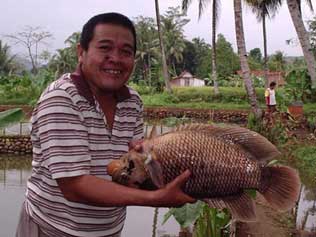Gurame Fish: Java
 I am a big fish lover and devour Gurame probably five times a week. It has a similar taste to that of the renowned Barramundi fish caught in the northern shores of Australia. Here is an interesting article by Agus Maryono about Gurame fish farmers.
I am a big fish lover and devour Gurame probably five times a week. It has a similar taste to that of the renowned Barramundi fish caught in the northern shores of Australia. Here is an interesting article by Agus Maryono about Gurame fish farmers.
Gurame Fish Farmers have a Reason to Smile
Agus Maryono, The Jakarta Post, Purwokerto
With a broad smile of pride, 43-year-old fish farmer Munajat showed off his gurame (Osphronemus Gouramy), which has become an essential part of his life.
Munajat tends to the fish from dawn to dusk at his fish farm in Karangsari village of Karanglewas district, Banyumas regency, Central Java.
He is so passionate about breeding gurame that he will speak eloquently and in detail about the potential of gurame farming, his analysis on the industry, the current conditions of fish farmers, and demand for fresh fish — both local and national.
Munajat is one of around 24,000 gurame breeders operating in Banyumas regency, but also one of the best, having won a national award for best freshwater fish breeder six years ago.
Gurame inland fisheries in the area, he said, had a very vast potential. Sadly, however, those of the younger generation were less interested in this business as a promising source of income.
“Extensive land is at our disposal, but it’s not yet optimally utilized. Most people still underestimate fishery and instead pursue office work,” Munajat pointed out last week.
His obvious commitment to the development of fish farms has made him chairman of the Banyumas Gurame Breeders Association since 2000.
In his home village of Karangsari, Munajat manages more than a dozen gurame breeding ponds, comprising separate ponds for nurturing roe, for raising parent stock and for fattening fish for consumption.
Known among fish farmers are the five stages of fish growth: larvae (one week), pumpkin seeds (30 days), horseradish leaves (70 days), matchboxes (3 months) and cigarette packs (155 days). “We serve all needs from stock to fish roe to fish ready for consumption,” he said.
Munajat said that gurame breeding was very lucrative because of the high market demand for the fish.
“Even its roe sells well, not only the fish for consumption,” he said.
He believes that if Indonesia’s fishery potential was optimized, everyone in the country could have fish every day.
In reality, the consumption rate is far below today’s national standard.
Munajat said Indonesians currently consumed an average 8.6 kilograms of fish per capita annually, compared to the ideal national standard of 24 kg/capita/year.
This consumption rate is “far too low (when) compared with the levels in advanced countries”, according to Munajat. “In Japan, the rate reaches 135 kg, and in Malaysia 80 kg,” he said.
“It’s very ironic, because Indonesia’s fishery potential in terms of natural and human resources is far greater than that of these two countries. But our potential is not yet optimally utilized, and the government’s role in developing this sector is still insignificant,” he said.
According to Munajat’s estimation, the 24,000 fish breeders in Banyumas can farm only about 400 hectares of the 1,600 hectares of land that are available to them. Their average annual production stands at 4,000 tons of gurame for consumption, against a national production rate of 25,000 tons a year.
“Only 10 percent of the Banyumas output is locally consumed while the rest is sold to other areas, mostly Jakarta,” he added.
The low freshwater fish cultivation in the regency, Munajat said, was partly due to a majority of unskilled human resources — that is, untrained fish farmers who use traditional methods and neglect technological advances in the industry. Another constraint was the government’s minimum attention to the industry’s potential.
“Particularly in terms of development and capital, the government still underestimates inland fishery,” noted Munajat.
In actuality, the prospects for freshwater fish breeding is very bright.
Munajat explained that fish roe of 5,000 eggs could sell at Rp 60,000. If nurtured for three months, the eggs would hatch and grow into 8-ounce matchbox-sized fish worth Rp 900.
“Assuming that over 50 percent of the eggs will fail to hatch, which leaves only about 2,400 (eggs), their value would reach Rp 2.16 million,” he said.
Meanwhile, the maximum production cost is 30 percent.
“So the business’ potential and prospects are great, but most Indonesians can’t see the benefits properly yet,” said Munajat.